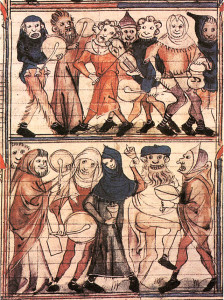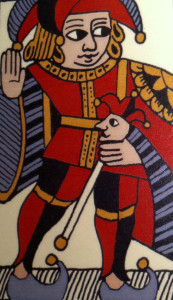FOURTH DAY of CHRISTMAS
The Feast of Fools
Numbers and balance play fascinating parts in the seasonal round of the year and in the varying traditions, both Pagan and Christian. Here, at the Fourth Day of Christmas, we reach a Christmas tradition whose roots go back further than the birth of Christ: It is the Feast of Fools, a direct descendent of the Roman Saturnalia that has given us so many of our Christmas traditions. The idea is simple: today, all order is turned upside down. Chaos ensues. This disintegration of order parallels the disintegration of the old year.
Back to the numbers: Twelve. Six of our twelve days of Christmas are in the old year, and six are in the new. For the first half of the Twelve Days, the old year is dying, disintegrating into chaos. It is the theme from time immemorial for this solstice tide: the old year must die for the new year to be born, the sun must die at the solstice to rise again, the son born at Christmas must die to rise again at Easter. The story is an ancient one, told over and over again. And come the new year, we welcome the other half of our Twelve Days. And there it is: balance and harmony, as the old year gives way to the new.
And so here today comes the Feast of Fools, a day not widely observed nowadays, but perhaps it should be. One of the grand things about the Feast of Fools is it gives us a chance to make tense situations more palatable through humor. For today, the children take charge of the house, the servants lord over the masters, the jester rules the court. Certainly there are simple things we can do: have breakfast for dinner (why not?). Take the cat for a walk. Let your guard down and be a little foolish. You will be in good company in a long line of wise yet silly people… like Charlie Chaplin, for instance. Here then, is a health to the comedians, who make us laugh at the silliness of our ways (even when we think we are being serious).
Image: Charlie Chaplin and his cat at their home in Switzerland, circa 1950s.


